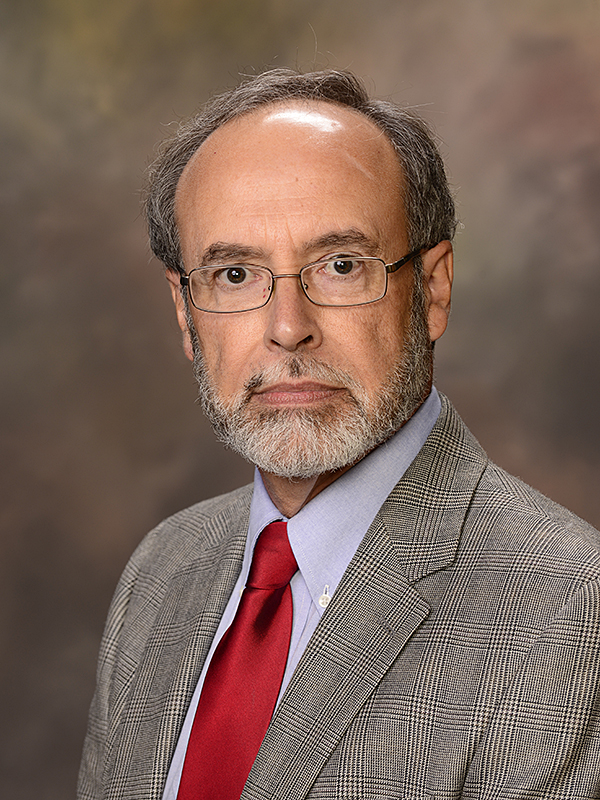COSAM »
COSAM Faculty »
Geosciences »
Ronald D. Lewis
Ronald Lewis
Geosciences
Associate Professor Emeritus
Research Areas:
Paleontology - The taphonomy of echinoderms and other invertebrates
Office: 2100 Beard Eaves Coliseum
Address:
2050 Beard Eaves Coliseum
Auburn, AL 36849
E-Mail: lewisrd@auburn.edu
Ph.D., Geology, University of Texas at Austin
1982
M.S., Geology, University of Iowa
1974
B.S., General Science, University of Iowa
1968
Professor Emeritus, Auburn University
2020 - Present
Associate Professor, Auburn University
1991 - 2020
Assistant Professor, Auburn University
1984 - 1991
Visiting Assistant Professor, Oberlin College
1982 - 1983
Assistant Professor, Knox College
1979 - 1982
Dr. Lewis is the co-author of a well-received laboratory manual for Historical Geology (Deciphering Earth History: Exercises in Historical Geology), with R.A. Gastaldo and C.E. Savrda, now in its fourth edition).
Research and Teaching Interests
Dr. Lewis' research deals primarily with the taphonomy of echinoderms and other invertebrates. Dr. Lewis is a strong advocate of the actualistic approach in paleontology, so present-day invertebrates are studied in their natural habitat and are often the subjects of field experiments. Currently, Dr. Lewis and his graduate students are studying the ecology and taphonomy of modern-day large benthic foraminifera at the outer islands of the Bahamas. The echinoid (sea urchin) fauna of the Bahamas is another current research interest of Dr. Lewis. Cretaceous and tertiary echinoid taphonomy are closely related research interests. Since coming to Auburn University, Dr. Lewis has established a program of teaching and research at the island of San Salvador in the Bahamas, applying the principles of actualistic paleontology to Recent and Pleistocene deposits there. To date, four M.S. theses have been completed based on student research done there, and three more are in progress. This program has been funded by Auburn University, the National Science Foundation, AAPG, and GSA. Dr. Lewis and Dr. Bruce Panuska of Mississippi State University recently edited and published the proceedings volume from the 11th Symposium on the Geology of the Bahamas and Other Carbonate Regions, which includes a good sampling of the varied research done at San Salvador by researchers from across the country. Dr. Lewis is also pursuing his interest in the history of actualistic research. Recently the focus has been on the life and contributions of Rudolf Richter. At the undergraduate lev, Dr. Lewis teaches Historical Geology and Principles of Paleontology, an introductory course in paleobiology. He also teaches Invertebrate Paleontology at the advanced-undergraduate and graduate level. This course emphasizes fossil preservation (taphonomy) and includes laboratory experiments. At the graduate level, Dr. Lewis and Dr. Wolf teach a professional development course called Geocommunication, a required course focusing on the journal article and research proposal. He also teaches the carbonate portion of Facies Analysis and Sequence Stratigraphy and, along with Dr. Savrda, he teaches a graduate seminar known as Issues in Paleontology. Directed Studies courses taught by Dr. Lewis include a course in Actualistic Paleontology, the study of modern-day organisms to better interpret life of the geologic past, and a field course in Carbonate Depositional Systems at San Salvador Bahamas.
FORAMINIFERA
- Lewis, R. D., Tichenor, H.R., Turner, O.C., and Morgan, J.L., 2013, The use of taphonomic grade and biovolume data to supplement relative abundance: Benthic foraminifera from San Salvador, Bahamas. Abstract for a talk given at the North American Micropaleontology Section (SEPM) meeting “Geologic Problem Solving with Microfossils III” held in Houston TX in March 2013.
- Lewis, R. D., Martin, L.D., and Tichenor, H.R., 2012, Zonation, growth rates, and calcium-carbonate production of attached (encrusting) benthic foraminifera at San Salvador, Bahamas [Talk]: Geological Society of America Abstracts with Programs, vol. 44, no.7, p.170.
- Martin, L.D., and Lewis, R. D., IN PRESS, Growth of attached (encrusting) benthic foraminifera along an offshore-onshore transect, Fernandez Bay, San Salvador, Bahamas: Preliminary results. Submitted for the proceedings volume of the 16th Symposium on the Geology of the Bahamas and other Carbonate Regions.
- Leon y Leon, I.A., and Lewis, R.D., 2012, Test abnormalities in benthic foraminifera from the Orange Beach area, Alabama: Assessing the effects of the Deepwater Horizon oil spill: Geological Society of America [Poster]: Abstracts with Programs, vol. 44, no. 4, p. 3.
- Buchan, O.C., and Lewis, R.D., 2009, Recent large benthic foraminifera as indicators of grassbed characteristics, San Salvador, Bahamas: The addition of taphonomy: in Demchuk, T.D., and Gary, A.C., eds, SEPM Special Publication, Geologic Problem Solving with Microfossils, vol. 93, p. 83-92.Lewis, R.D., 2009, Geracia bahamensis new genus and species, a Recent agglutinated foraminifer from the platform margin at San Salvador, Bahamas: Micropaleontology, v. 55, v. 6, 6 p.
CRINOIDS
- Thomka, J.R, Mosher, D., Lewis, R.D., and Pabian, R.K., 2012, The utility of isolated crinoid ossicles and fragmentary crinoid remains in taphonomic and paleoenvironmental analysis: An example from the Upper Pennsylvanian of Oklahoma, Midcontinent North America: PALAIOS, v. 27, p. 465-480.
- Thomka, J.R, Lewis, R.D., Mosher, D., Pabian, R.K., and Holterhoff, P.F., 2011, Genus-level taphonomic variation within cladid crinoids from the Upper Pennsylvanian Barnsdall Formation, northeastern Oklahoma: PALAIOS, v. 26, p. 377-389.
Lab/Research Page
Last updated:
07/08/2021

